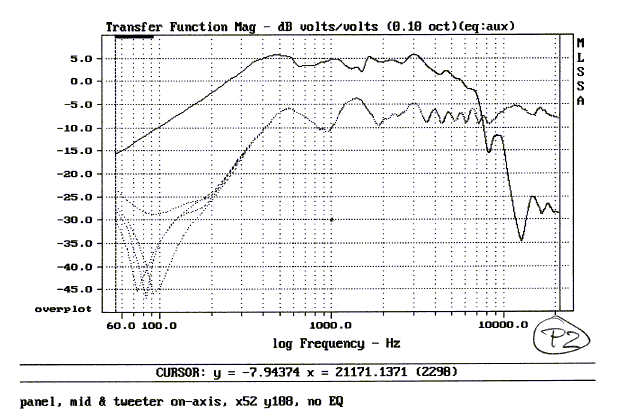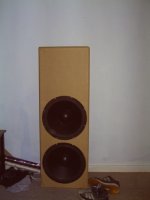I've been following the many threads on the forum, and have read the massive site the is www.linkwitzlab.com , and I decided that its about time I try this open baffle thingy for myself.
So not wanting to waste vast sums of money, and being the kind of person I am, not wanting to copy someone elses design, I searched for the cheapest drivers around, to have a play with.
I've collected a couple of 15" woofers, a couple of 6.5" mids and a cheap silk dome tweeter, with the intention of throwing 1 speaker together, to see what I can realistically achieve.
The drivers so far have come to a total of £70.00 ($126 US), and they arrived this week.
I've created a 420mm baffle with 160mm wings at 90°, and will have the 2 15" woofers at the bottom and the 2 6.5" mid/woofers in an MTM arrangement at the top. I'm going to aim for cross over points of 200Hz and 2500Hz.
Progess so far? Just about got the baffle together and the woofer in.
So not wanting to waste vast sums of money, and being the kind of person I am, not wanting to copy someone elses design, I searched for the cheapest drivers around, to have a play with.
I've collected a couple of 15" woofers, a couple of 6.5" mids and a cheap silk dome tweeter, with the intention of throwing 1 speaker together, to see what I can realistically achieve.
The drivers so far have come to a total of £70.00 ($126 US), and they arrived this week.
I've created a 420mm baffle with 160mm wings at 90°, and will have the 2 15" woofers at the bottom and the 2 6.5" mid/woofers in an MTM arrangement at the top. I'm going to aim for cross over points of 200Hz and 2500Hz.
Progess so far? Just about got the baffle together and the woofer in.
Attachments
I'm interested in dipole bass as well. Please let the forum know if you get viable results or take measurements.
Good Luck.
Ribbon Project
Good Luck.
Ribbon Project
Mutley666 said:I
I've created a 420mm baffle with 160mm wings at 90°, and will have the 2 15" woofers at the bottom and the 2 6.5" mid/woofers in an MTM arrangement at the top. I'm going to aim for cross over points of 200Hz and 2500Hz.
Progess so far? Just about got the baffle together and the woofer in.
Hi,
just an observation :
given the 6dB roll-off of open baffles sensitivity is a moot issue.
Its more likely you would get good results with one 6.5" driver.
(Space it unequally from the 3 edges to smooth diffraction effects)
You could then crossover to the top 15" near baffle transition.
Hopefully the (presumably) higher sensistivity 15" would then
compensate for the initial baffle roll-off.
You could then bring in the other 15" lowerdown, this would
compensate one octave (6dB) of roll-off.
Presumably below some point you'll need 6dB/octave active boost.
Hi,
I'm suggesting more than a 2.5 way, a 3.5 way.
The 0.5 way on the 2 bass units will compensate for one octave of baffle loss.
If one bass unit is more sensitive than the mid unit, then if the
bass/mid c/o point is a shallow 1st order around the point that
baffle loss begins then the sensitivity diffrence could compensate
for some initial baffle loss.
Note that without measurements this is partly conjecture.
A driver in the centre of a baffle can exhibit strong diffraction ripples.
It may be better to allow a carefully placed mid unit to go somewhat
lower with some active boost, and bring in the bass units lower when
there is already significant baffle loss but below the frequency the
bass units exhibit significant ripples.
In this case you might need a two stage bass boost arrangement.
 /sreten.
/sreten.
I'm suggesting more than a 2.5 way, a 3.5 way.
The 0.5 way on the 2 bass units will compensate for one octave of baffle loss.
If one bass unit is more sensitive than the mid unit, then if the
bass/mid c/o point is a shallow 1st order around the point that
baffle loss begins then the sensitivity diffrence could compensate
for some initial baffle loss.
Note that without measurements this is partly conjecture.
A driver in the centre of a baffle can exhibit strong diffraction ripples.
It may be better to allow a carefully placed mid unit to go somewhat
lower with some active boost, and bring in the bass units lower when
there is already significant baffle loss but below the frequency the
bass units exhibit significant ripples.
In this case you might need a two stage bass boost arrangement.
sreten said:... there is already significant baffle loss but below the frequency the bass units exhibit significant ripples. ...
sreten,
my OBs are developing along similar lines as Mutleys: two 15"woofers, conus mid and horn tweeter. But I don´t see where the bass units could exhibit significant ripples if they are x-overed below 500 Hz. Could you explain? Is it edge diffraction? Floor reflection? Anything else?
Rudolf
Rudolf said:
sreten,
my OBs are developing along similar lines as Mutleys: two 15"woofers, conus mid and horn tweeter. But I don´t see where the bass units could exhibit significant ripples if they are x-overed below 500 Hz. Could you explain? Is it edge diffraction? Floor reflection? Anything else?
Rudolf
Hi,
I've seen plots of speakers on open baffles with significant peaks
and dips, typically a dip then peak going downwards in frequency
into the 6/dB octave transition region.
500Hz ? I think you'd need to be a lot lower to avoid ripples, but
it is possible the overall response of the 2 15's is relatively smooth.
This would be because the large cone area has more variation of
distance to the baffle edge than say a small centrally mounted driver.
Ripple frequency is lower for wider baffles.
As I said my comments are partly conjecture, I'm no expert on open baffles.
8" MTM on a small baffle (~12" wide) (from linkwitzlab.com):

Here the ripple effect is clearly illustrated by the tweeter,
and somewhat smoother for the two 8" drivers.
Sreten, you are correct.
Skytronic drivers they are! Cheap and easily available.... perfect for experimentation! Like I stated in my original post, I got two 6.5", two 15" and 2 tweeters for about £70.00 including postage.
The T/S parameters are available on the skytronic website.
I will probably go with something like the Peerless SLS range for the finished speaker.
Skytronic drivers they are! Cheap and easily available.... perfect for experimentation! Like I stated in my original post, I got two 6.5", two 15" and 2 tweeters for about £70.00 including postage.
The T/S parameters are available on the skytronic website.
I will probably go with something like the Peerless SLS range for the finished speaker.
Yes, the 15" drivers are the 902.184 with a qts of 0.92.
I have read the posts here and the information on linkwitz's site, which seem to suggest that the higher Q of the woofer the less EQ is needed.
I would ideally like to use completely passively EQ, like the JAMO R909, but if needs be Ill build some ChipAmps and go active.
I have read the posts here and the information on linkwitz's site, which seem to suggest that the higher Q of the woofer the less EQ is needed.
I would ideally like to use completely passively EQ, like the JAMO R909, but if needs be Ill build some ChipAmps and go active.
Mutley666 said:I would ideally like to use completely passively EQ, like the JAMO R909, but if needs be Ill build some ChipAmps and go active.
It´s not a question of needs, but one of economics.
A passive X-over at 200 Hz or lower is not cheap, and equalising the 6 dB dipole rolloff with passive means will turn a LOT of amp power into heat. So you better dedicate an amp to the woofer section and do that X-over and equalising at the line level side of the amp.
Mutley666 said:Yes, the 15" drivers are the 902.184 with a qts of 0.92.
which seem to suggest that the higher Q of the woofer the less EQ is needed.
Hi,
yes, less EQ will be needed, the SLS on the other hand needs lots of EQ.
Making a passive version of the speaker much more difficult.
If your prototypes are a success, updating the midrange and treble
would seem to me to be cost effective, keeping the bass units.
Mounting the lower bass unit in reverse (and reverse phase)
should reduce 3rd harmonic distortion at low frequecies.
Mounting the lower bass unit in reverse (and reverse phase)
Yeah, I know..... but the wife has spoken and I have to at least make an attempt to make it look half way acceptable. I have managed to convince her to let me build some speakers the are almost as tall as she is!
I think you maybe right on keeping the 15" drivers for the final speaker. Having looked at the Qts of the SLS range the EQ would need to be quite large and costly.
Maybe I'll keep these cheap woofers and spend the money on some Excel mid/woofers instead.
I'm going to have to re-read Linkwitz's information. I seam to remember that he stated the high-Q drivers, needed less EQ but had significant other issues, and that in the end, lower Q was still the better choice with additional EQ. Am i missing something?
I also remember a flame going on in another recent thread over this very same issue....High Q vs lower Q drivers. Someone had apparently built a system using four cheap 15" pro drivers and made great claims about the performance down low, while others with more experience were saying No Way.
Regards...
Ribbon Project
I also remember a flame going on in another recent thread over this very same issue....High Q vs lower Q drivers. Someone had apparently built a system using four cheap 15" pro drivers and made great claims about the performance down low, while others with more experience were saying No Way.
Regards...
Ribbon Project
I do not recommend the use of drivers with very small magnets and Qts >> 0.8 in an attempt to compensate for the 6 dB/oct open-baffle roll-off with a rising driver response. Such equalization is crude at best. I prefer active 6 dB/oct low-pass filter equalization.
This is what he says. I am also in the (very long because too little time) process of doing a similar speaker thing.
The issues will likely be phase distortions, which means delay issues that are recognizable by the ear, at least SL says so.
Regards,
Lukas
- Status
- This old topic is closed. If you want to reopen this topic, contact a moderator using the "Report Post" button.
- Home
- Loudspeakers
- Multi-Way
- Time To Try Open Baffle
